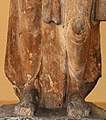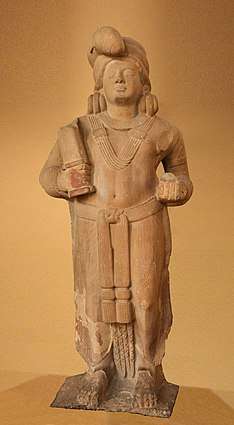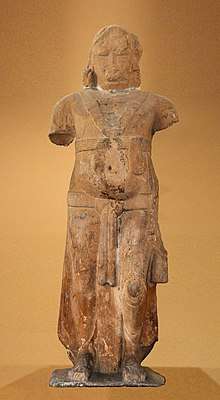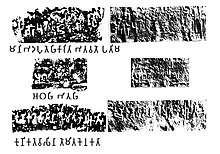Parkham Yaksha
The Parkham Yaksha is a colossal statue of a Yaksha, discovered in the area of Parkham, in the vicinity of Mathura, 22.5 kilometers south of the city.[1] The statue, which is an important artefact of the Art of Mathura, is now visible in the Mathura Museum. It has been identified as the Yaksha deity Manibhadra, a popular deity in ancient India.
| Parkham Yaksha | |
|---|---|
Front Back The "Parkam Yaksha" Manibhadra. 150 BCE. Mathura Museum, GMM C.1[1] | |
| Size | 2.6 meters |
| Writing | Brahmi |
| Created | 150 BCE |
| Discovered | Parkham, Uttar-Pradesh 27.287358°N 77.717414°E |
| Present location | Mathura Museum, Mathura |
| Registration | GMM C.1 |
Date
The Parkham Yaksha is datable to period 200 BCE – 50 BCE on paleographic and stylistic grounds.[2][3] It has also been dated more precisely by Heinrich Lüders, who gives it a mid-2nd century date, and Sonya Rhie Quintanilla who dates it to circa 150 BCE.[1]
Inscription
The statue is 2.6 meters tall, including its base of about 30 centimeters.[1] The badly corroded inscription in early Brahmi script on the top side of the base reads:
Parkham Yaksha inscription with transliteration, paleographically dated to mid-2nd century BCE.[4](𑀫𑀸)𑀦𑀺𑀪𑀤𑀧𑀼𑀢𑁂(𑀳𑀺) 𑀓𑀸(𑀭𑀺)(𑀢𑀸) (𑀪)𑀢(𑀯)𑀢𑁄 (𑀧𑀢𑀺𑀫)
(Mā)nibhadapuge[h]i kā(r)i(t)ā (bha)ga[va]to (patimā)
𑀅𑀞(𑀳𑀺) (𑀪𑀸𑀢𑀼)𑀳𑀺
aṭha(h)i [bhātu]hi
𑀓𑀼𑀡𑀺𑀓𑀢𑁂𑀯𑀸𑀲𑀺𑀦𑀸 𑀢𑁄𑀫𑀺𑀢𑀓𑁂𑀦 𑀓𑀢𑀸
Kuṇikatevāsinā Gomitakena katā"The image of the Holy One was caused to be made by eight brothers, members of the Manibhada congregation. It has been made by Gomitaka, the pupil of Kunika.
This inscription thus indicates that the statue represents the Yaksa Manibhadra, and the title "Bhagavat" ("Lord" or "Holy One") suggests that the statue represents a divinity in its own right, which was the subject of worship, independently of Buddhism or Jainism with which it was later associated.[1][6]
Style
The analysis of the statue has suggested that the Parkham Yaksha probably held his left arm akimbo, while holding a bag filled with square coins, as seen in the Manibhadra statue of Pawaya.[1] According to John Boardman, the hem of the dress is derived from Greek art. Describing a similar statue, John Boardman writes: "It has no local antecedents and looks most like a Greek Late Archaic mannerism". Similar folds can be seen in the Bharhut Yavana.[7]
The Parkham Yaksha is one of four known occurrences of the Yaksha Manibhadra in inscriptions: one in Parkham near Mathura, one in Pawaya near Gwalior, one in Masharfa and one in Bhītā near Kausambi.[1] It appears Manibhadra was considered as a protector of itenerant merchants, a provider of wealth, and a protector against smallpox.[1]

 A similar statue, but in a much better state of preservation, the Mudgarpani Yaksha
A similar statue, but in a much better state of preservation, the Mudgarpani Yaksha
References
- Dated 150 BCE in Fig. 15-17, general comments p.26-27 in Quintanilla, Sonya Rhie (2007). History of Early Stone Sculpture at Mathura: Ca. 150 BCE - 100 CE. BRILL. ISBN 9789004155374.
- Ayyar, Sulochana (1987). Costumes and Ornaments as Depicted in the Sculptures of Gwalior Museum. Mittal Publications. p. 29. ISBN 978-81-7099-002-4.
- Luders, Heinrich (1961). Mathura Inscriptions. p. 179.
- Luders, Heinrich (1961). Mathura Inscriptions. p. 179.
- Lüders, Heinrich (1961). Mathura Inscriptions.
- Singh, Upinder (2008). A History of Ancient and Early Medieval India: From the Stone Age to the 12th Century. Pearson Education India. ISBN 978-81-317-1120-0.
- Boardman, John (1993). The Diffusion of Classical Art in Antiquity. Princeton University Press. p. 112. ISBN 0691036802.
Sources
- Mathew, Ammu (2008). ManoramaTell me why No.32. Monorama Press. ISBN 0-9750-4300-5.
- Hopkins, Edward Washburn (1915). Epic mythology. Strassburg K.J. Trübner. ISBN 0-8426-0560-6.CS1 maint: ref=harv (link)
- Sutherland, Gail Hinich (1991). The disguises of the demon: the development of the Yakṣa in Hinduism and Buddhism. SUNY Press. ISBN 0-7914-0622-9.CS1 maint: ref=harv (link)

.jpg)

